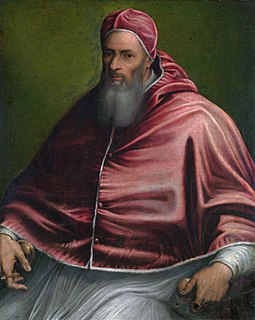
Pope Julius III, born Giovanni Maria Ciocchi del Monte, was head of the Catholic Church and ruler of the Papal States from 7 February 1550 to his death in 1555.

Monte Cassino is a rocky hill about 130 kilometres (80 mi) southeast of Rome, in the Latin Valley, Italy, 2 kilometres west of Cassino and at an elevation of 520 m (1,710 ft). Site of the Roman town of Casinum, it is widely known for its abbey, the first house of the Benedictine Order, having been established by Benedict of Nursia himself around 529. It was for the community of Monte Cassino that the Rule of Saint Benedict was composed.

The Quirinal Hill is one of the Seven Hills of Rome, at the north-east of the city center. It is the location of the official residence of the Italian head of state, who resides in the Quirinal Palace; by metonymy "the Quirinal" has come to stand for the Italian president. The Quirinal Palace has an extension of 1.2 million square feet.
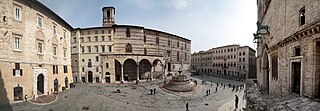
Perugia is the capital city of Umbria in central Italy, crossed by the River Tiber, and of the province of Perugia. The city is located about 164 km (102 mi) north of Rome and 148 km (92 mi) southeast of Florence. It covers a high hilltop and part of the valleys around the area. The region of Umbria is bordered by Tuscany, Lazio, and Marche.

Trieste is a city and seaport in northeastern Italy. It is the capital city, and largest city, of the autonomous region of Friuli Venezia Giulia, one of two autonomous regions which are not subdivided into provinces.
Assisi is a town and comune of Italy in the Province of Perugia in the Umbria region, on the western flank of Monte Subasio.
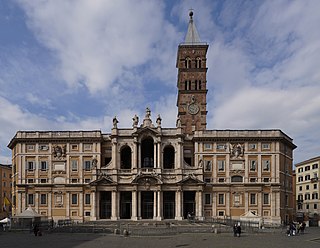
The Basilica of Saint Mary Major, or church of Santa Maria Maggiore, is a Major papal basilica as well as one of the Seven Pilgrim Churches of Rome and the largest Catholic Marian church in Rome, Italy.

Rezzato is a comune in the province of Brescia, in Lombardy. It is bounded by the comunes of Brescia, Botticino, Castenedolo, Mazzano and Nuvolera.

Velletri is an Italian comune in the Metropolitan City of Rome, approximately 40 km to the southeast of the city centre, located in the Alban Hills, in the region of Lazio, central Italy. Neighbouring communes are Rocca di Papa, Lariano, Cisterna di Latina, Artena, Aprilia, Nemi, Genzano di Roma, and Lanuvio. Its motto is: Est mihi libertas papalis et imperialis.

The Basilica della Santa Casa is a Marian shrine in Loreto, in the Marches, Italy. The basilica is known for enshrining the house in which the Blessed Virgin Mary is believed by some Catholics to have lived. Pious legends claim the same house was flown over by angelic beings from Nazareth to Tersatto, then to Recanati, before arriving at the current site.

The Holy Family consists of the Child Jesus, the Virgin Mary and Saint Joseph. The subject became popular in art from the 1490s on, but veneration of the Holy Family was formally begun in the 17th century by Saint François de Laval, the first bishop of New France, who founded a confraternity.

The Basilica of Saint Praxedes, commonly known in Italian as Santa Prassede, is an early medieval titular church and minor basilica located near the papal basilica of Saint Mary Major, on Via di Santa Prassede, 9/a in rione Monti of Rome, Italy. The current Cardinal Priest of Titulus Sancta Praxedis is Paul Poupard.

The Basilica of St. Stephen in the Round on the Celian Hill is an ancient basilica and titular church in Rome, Italy. Commonly named Santo Stefano Rotondo, the church is Hungary's "national church" in Rome, dedicated to both Saint Stephen, the first Christian martyr, and Stephen I, the sanctified first king of Hungary who converted to Christianity and promoted it in his kingdom. The minor basilica is also the rectory church of the Pontifical Collegium Germanicum et Hungaricum.
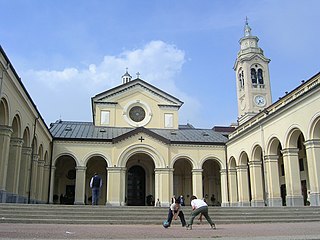
The Shrine of Nostra Signora della Guardia is a Roman Catholic place of pilgrimage located on the top of Monte Figogna in the Municipality of Ceranesi, about 20 kilometres from the city of Genoa, in the northwest of Italy.
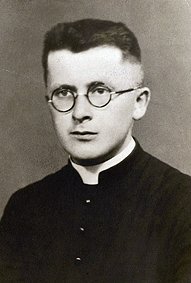
Francesco Giovanni Bonifacio was an Italian Catholic priest, killed by the Yugoslav communists in Grisignana ; he was beatified in Trieste on October 4, 2008.
The following is a timeline of the history of the city of Trieste in the Friuli-Venezia Giulia region of Italy.
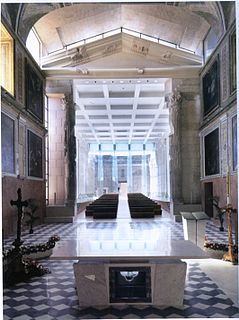
Pozzuoli Cathedral or the Basilica of San Procolo martire is the main Roman Catholic church in Pozzuoli and the seat of the Diocese of Pozzuoli. It sits at the top of the Rione Terra and is built around an ancient Roman temple.

The Church of Sant'Antonio Taumaturgo, is the main religious building in the Borgo Teresiano in the centre of Trieste as well as the city's largest Catholic church. It stands on a square also known as Sant’Antonio Nuovo, at the end of the Grand Canal.
Antonio Santin, was an Italian bishop of the Roman Catholic Church. He was Bishop of Rijeka, Bishop of Koper (Slovenia), Bishop of Trieste (Italy), and was created Archbishop ad personam.
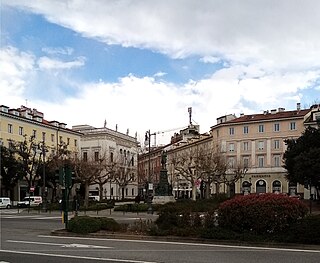
Piazza Venezia is one of the best known squares of Trieste, the capital of Friuli Venezia Giulia, Italy. The square has a view over the Adriatic to the Alps with the Dolomite Mountains Civetta, Monte Pelmo and Antelao. The square is known for its central monument and its prominent buildings and their features: the Revoltella Palace designed by Friedrich Hitzig, with its furnishings and art collection, today including over 350 pieces, the historic Mizzan pharmacy, still conserving the original furnishing, with carved boiserie and fire-worked stained glass windows with mythological images, and the monument of Maximilian I of Mexico, the work of sculptor Johannes Schilling. The square is connected to via Torino, often credited as the center of Trieste's nightlife.


















